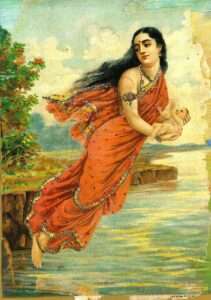Years had passed, and Pratipa had grown old. So, he retired to the forest to spend the last years of his life in devotional service and meditation.
Shantanu had inherited his father’s throne and ruled with equal righteousness and ability.
Still being young, he particularly loved long walks on the banks of the Ganges, alone, absorbed in a serene and peaceful state of mind. He felt satisfied because the people, happy with his way of governing, respected the laws and lived peacefully.
One day, while he was walking aimlessly on the banks of the sacred river, he saw a beautiful girl who, with no one to accompany her, came to meet him, looking at him insistently. The situation was somewhat unusual because sunset was approaching and the girls usually did not walk around alone at that time of the day. He walked over.
“What are you doing here alone?” he asked gently. “The day is coming to an end and the sun has already hidden behind the horizon. It will be dark soon, and it is dangerous for a girl to walk around without a companion.”
She didn’t answer.
“You have a soft, sweet appearance,” Shantanu resumed, “and your beauty is irresistible. You intrigue me. Tell me, who are you and where do you come from? Who is your husband and who are your parents?”
“I don’t have a husband; I’m a single girl,” she replied, “and I’m walking along these shores without a reason or a precise destination. As for my name and my origin, I don’t want to reveal them to anyone for now. Rather, tell me, who are you? From the clothes you wear you look like a Kshatriya of noble birth.”
“My name is Shantanu,” he replied, “and I am the king of these lands. It doesn’t matter if you don’t want to tell me your name for now, but know that you have already won my heart, and that I would like you by my side as a wife.”
The girl smiled. The king was a handsome, proud-looking young man; she too felt attracted to him.
“How could I refuse such an opportunity? I certainly accept, but I need to set some conditions.”
Hearing those words, Shantanu was happy. That girl had such a gentle, almost melodious voice that it sweetened the heart. He felt enraptured by that celestial beauty and was willing to do anything to have her with him.
“I am the king of vast territories, and I have no difficulty in fulfilling any of your wishes. Tell me what you want and you will have it.”
The mysterious girl said:
“You must never demand to know my name or my origin, and neither object nor criticize anything I do, even those actions that might seem the strangest. If you accept these conditions without even knowing why I impose them, I will be happy to marry you and come to live with you. But if you break this covenant I will leave immediately. Think about it, then.”
The king was so taken with that girl that he didn’t even think about what this might entail and accepted all her conditions. Together they went to Hastinapura and a few days later the wedding was celebrated.
More than a year had passed since that day and it had been a time of intense rejoicing and happiness. The king was happy and satisfied along with his beloved queen.
A little later she gave birth to a boy, but the happiness was stifled by an unexpected tragedy: to everyone’s amazement and horror, the queen took the newborn and threw him into the Ganges, killing him.
Shantanu, who had waited so long for his heir, was desperate, but he could not say anything, remembering the conditions she had set: he must not hinder or criticize his wife’s actions, otherwise she would abandon him. Apart from what seemed like a moment of madness to everyone, she was otherwise an exceptional woman, loving, kind, deeply attached to her husband and her duties as wife and queen.
Then, the second son was born, and he had the same fate as the first. And then the third and the fourth. Shantanu was desperate. He could not understand the reasons for such behavior. What prompted her to kill her children? But he was too afraid of losing her to protest.
This is a section of the book “Maha-bharata, Vol. 1”.
To buy the complete book, click above
Post view 634 times




Leave a Reply